Table of Contents
ToggleTypes of Lights Used in Volleyball Courts
Flood Lights
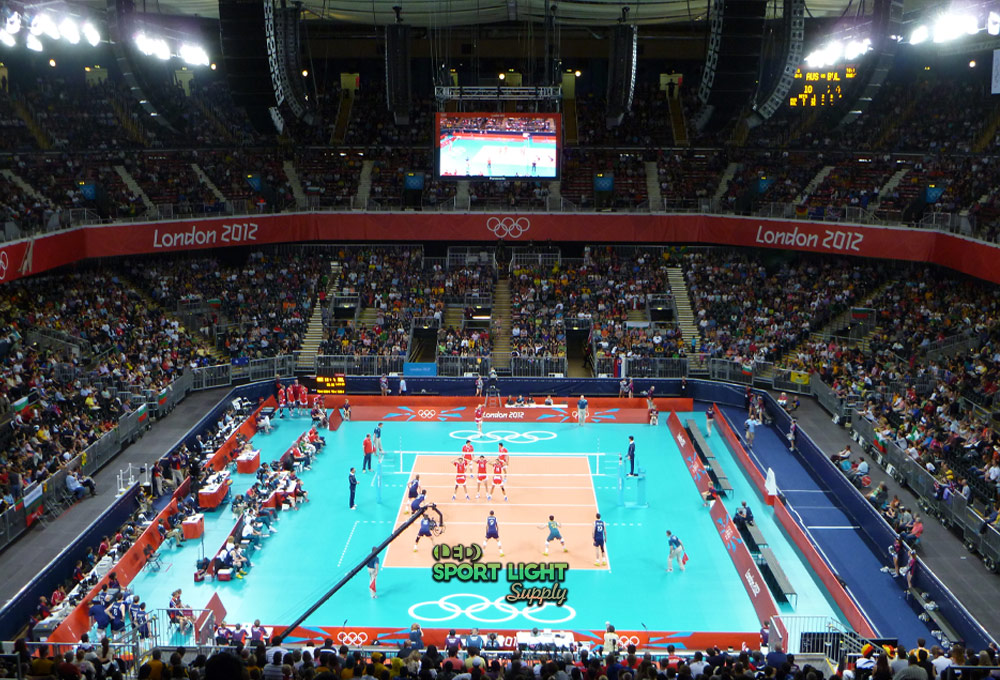
Flood lights are a common choice for lighting volleyball courts, whether for sand or indoor volleyball. These lights are typically mounted on poles, frames, or towers and provide broad, uniform illumination over the playing area.
Modern flood lights often feature LED technology, offering enhanced efficiency and longevity compared to older models. They are especially useful for general lighting needs and can help address various illuminance challenges. Some flood lights are equipped with solar panels, making them suitable for temporary or security lighting applications. These solar-powered options offer the added benefit of being portable and easy to install, as they don’t require complex wiring.
Typically, flood lights consist of a frame with a glass cover, an LED chip inside a reflector, and a housing with a driver.
Spot Lights
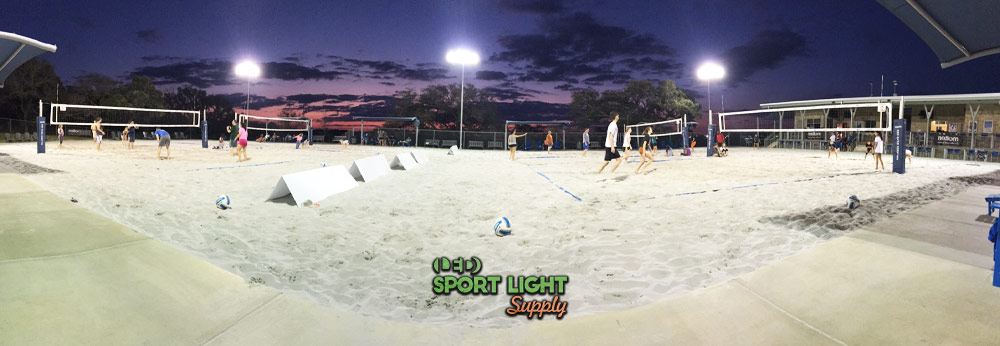
Spot lights serve as an excellent option for long-range illumination on volleyball courts. They are designed to focus light on specific areas, making them ideal for highlighting particular sections of the court or for use in specialized lighting setups.
Spot lights are often oval or circular and come with various mounting options, including high masts, walls, or custom structures. They are equipped with features such as c-clamps, hooks, and safety cables to direct the light precisely where it’s needed. The design allows for adjustable beams through shutters, enabling users to control the spread and intensity of the light.
Spot lights are versatile and can be used in combination with other lighting solutions or installed on portable setups to address lighting deficiencies.
Solar Lights
Solar lights are a practical choice for outdoor sand volleyball courts. These fixtures utilize solar energy to charge a battery, which powers the LED lights when daylight fades. Solar lights typically include a photovoltaic panel and a lithium battery, providing energy-efficient lighting with minimal installation effort.
These lights are particularly advantageous for their ease of installation and lack of need for cumbersome cables or adapters. They generally offer around four hours of illumination on a full charge, which is sufficient for late afternoon training sessions or recreational play. Solar lights are also a cost-effective option, reducing energy bills and installation expenses.
High Bay Lights
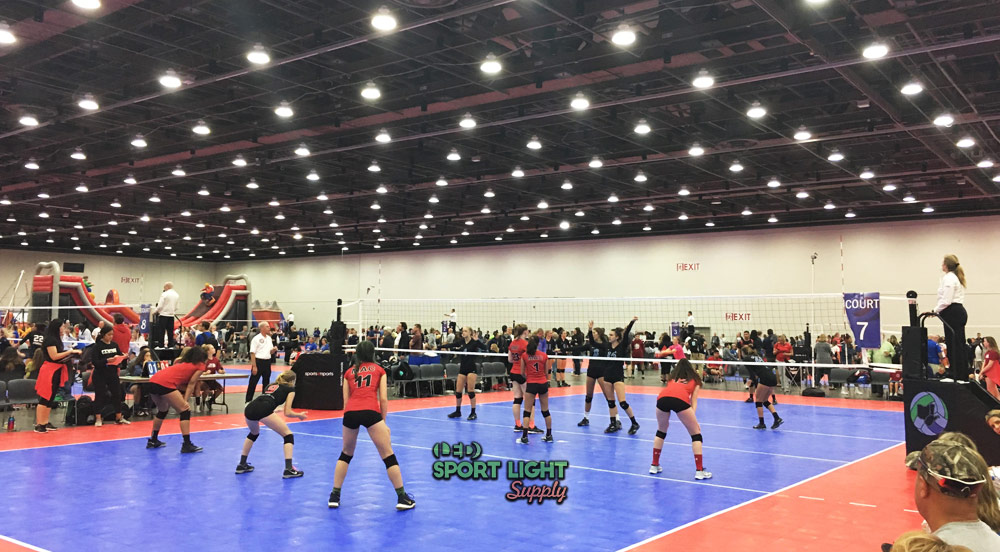
High bay lights are designed for indoor volleyball courts and are an excellent choice for venues such as gyms, colleges, and sports clubs. They provide vertical lighting that enhances visibility for both players and referees, which is crucial for accurate play and officiating.
High bay lights are typically mounted on the ceiling and come in various forms, including round (UFO-style) and linear designs. Round high bay lights offer a concentrated beam, while linear high bay lights provide a wider beam angle for more comprehensive coverage. These lights help reduce shadows and improve overall court visibility, addressing the increased lighting demands of modern volleyball standards.
Ideas for Lighting Up a Volleyball Court
Pole Lights
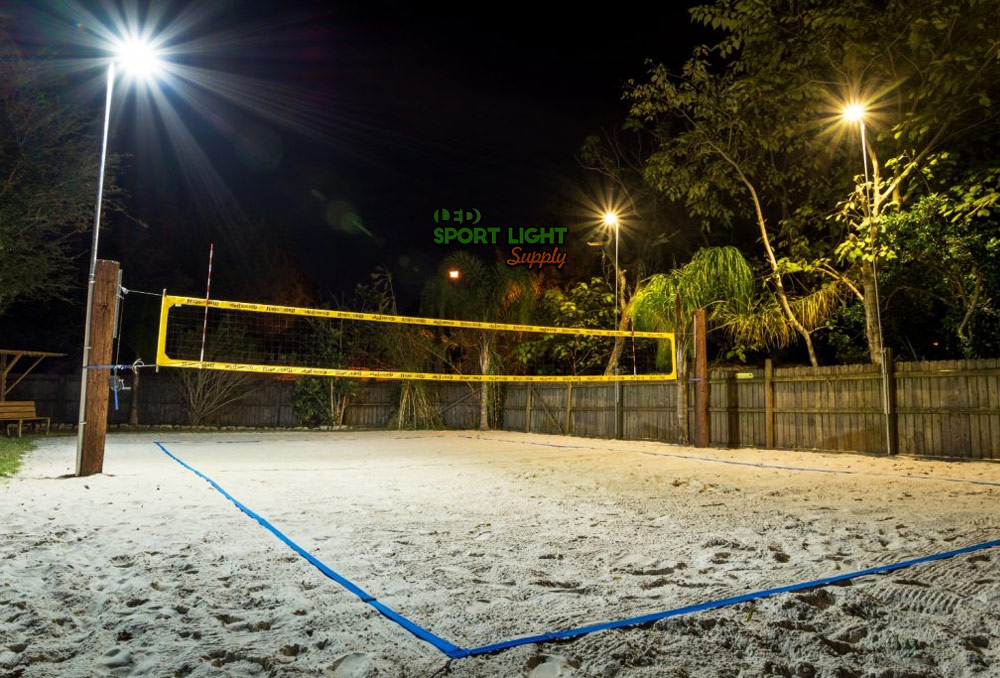
An effective and cost-efficient lighting design for an outdoor volleyball court involves using 2 to 4 light poles. Position the poles along the sides of the court, in alignment with the volleyball net. Alternatively, you can place a single high mast between adjacent courts to reduce running costs further. If opting for a 3-pole configuration, the central high mast can be equipped with a luminaire ring to enhance lighting uniformity.
For beach volleyball, it is crucial to consider the height of the light poles. The poles should be taller than the net but not excessively high. A popular choice is solar lighting, which requires poles about 20 feet tall to achieve at least 10 foot-candles (107.6 lux) in the front zone. Measurements from the center line should meet a minimum lux level and ensure a lighting uniformity ratio of at least 2.07 (max/min illuminance).
Portable Light Towers
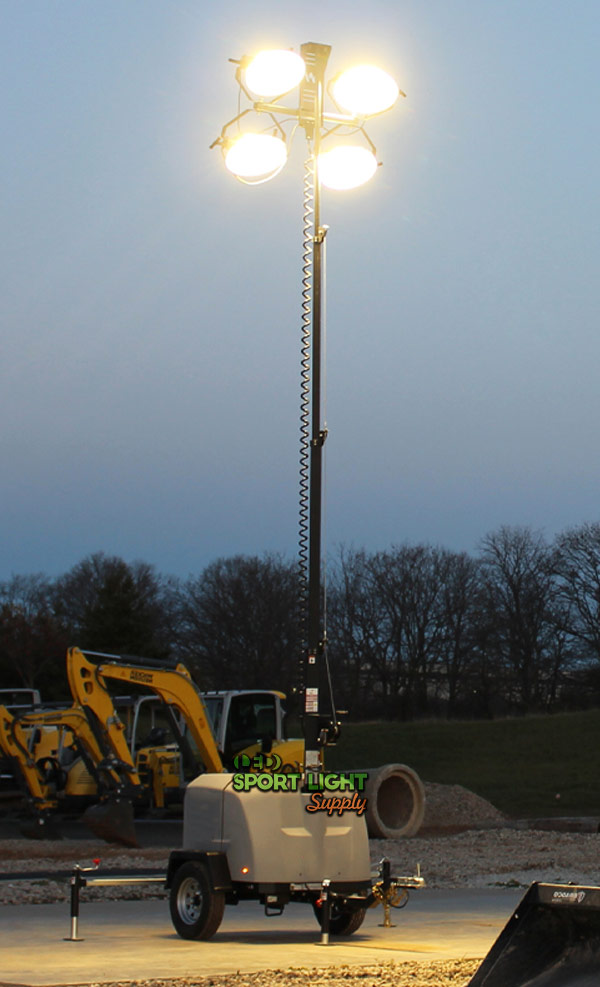
Portable light towers offer versatility, primarily serving as temporary lighting solutions. They are particularly useful for volleyball courts without permanent poles, or if you prefer not to install permanent structures. Portable towers provide multiple benefits:
Variety of Options
Portable light towers come in a range of models, each designed to meet different requirements. Whether you need lighting for a small local event or a large outdoor venue, there is a model available to fit your specific needs. Some models are designed with higher lumen outputs for greater illumination, while others are more compact and suitable for lower-intensity lighting tasks. Additionally, features such as integrated generators, various mounting options, and different power sources allow for customization based on the setting and duration of use. This variety ensures that you can select a light tower that best matches your operational needs and budget constraints, providing flexibility for a wide range of applications.
Temporary or Emergency Lighting
One of the key advantages of portable light towers is their suitability for temporary or emergency lighting scenarios. These units are particularly useful for situations where permanent lighting installations are not feasible or practical. For instance, they can be deployed quickly to illuminate sports events, construction sites, or emergency response areas. Their portability means that they can be moved and repositioned as needed, offering a dynamic solution for changing lighting requirements. Whether you need to light up a volleyball court for an evening game or provide emergency lighting during a power outage, portable light towers offer a reliable and adaptable solution.
Adjustable Height
The adjustable height feature of portable light towers adds significant versatility to their use. Many models come with telescopic poles that can be extended or retracted, allowing you to customize the height of the lighting based on your specific needs. This adjustability can be managed either manually or through mechanical systems, with some modern models offering remote control options via smartphone apps. The ability to adjust the height ensures optimal illumination coverage, whether you need to focus light on a small area or spread it across a larger space. This flexibility enhances the effectiveness of the lighting and ensures that it meets the varying demands of different events or conditions.
Many models come with additional features such as generators, trailer hooks, and wheels. For optimal coverage, use 2 to 4 light towers per volleyball court, positioning them at corners or along the sidelines. Modern portable light towers often feature telescopic poles ranging from 4 to 8 meters, with height adjustment possible via manual control or even smartphone apps.
Solar Lights
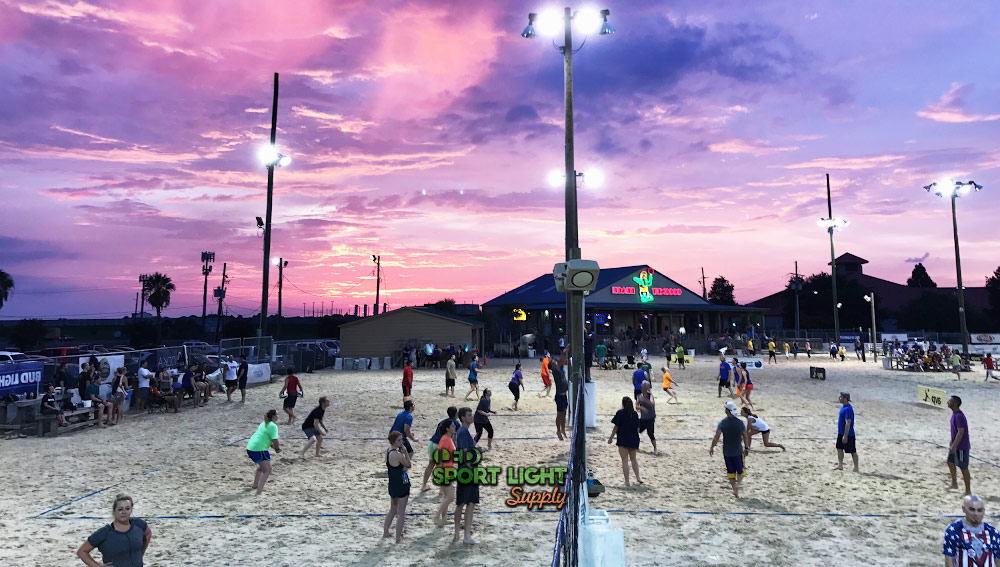
Nighttime volleyball games, especially on a beach with ocean waves as a backdrop, can be beautifully illuminated using solar lights. Installing solar lights is a practical solution for outdoor courts, reducing electricity costs and eliminating complex wiring.
Solar lights are effective for outdoor use and rely on sunlight for recharging. They typically provide illumination for 4 to 8 hours once fully charged. Performance can be affected by several factors:
Battery Wear and Tear
The performance of solar lights is significantly influenced by the wear and tear of their batteries. As batteries age, their ability to hold a charge diminishes, leading to reduced illumination time and intensity. Standard batteries have a finite lifespan, which can be affected by factors such as the frequency of use, the number of charge cycles, and the operating environment. Over time, the degradation of the battery can result in less reliable performance, necessitating more frequent replacements or maintenance to ensure consistent lighting.
IP Rating
The Ingress Protection (IP) rating of solar lights is crucial for determining their resistance to environmental factors such as rain and dust. An inadequate IP rating can leave the lights vulnerable to moisture and particulate ingress, potentially compromising their functionality and longevity. Lights with low IP ratings may suffer from damage or reduced efficiency when exposed to harsh weather conditions, which is especially important in outdoor settings. Choosing solar lights with a higher IP rating ensures better protection against these elements and contributes to more durable and reliable performance.
General Aging
Over time, the general aging of solar lights can impact their efficiency and effectiveness. As the components of the lights, including the solar panels and LED bulbs, undergo continuous use, their performance can gradually decline. Factors such as exposure to UV rays, temperature fluctuations, and physical wear can contribute to this decline. As a result, the illumination provided by the lights may decrease, and their overall energy efficiency may diminish. Regular maintenance and timely replacements of worn components are essential to maintaining optimal performance and extending the lifespan of solar lighting systems.
Since solar LED lights may not be as powerful as traditional high mast floodlighting, consider adding LED strips to the volleyball net for additional illumination. Ensure that the solar lights are securely mounted to withstand high wind conditions.
Common Mistakes When Lighting Up a Volleyball Court
Insufficient Lighting
One common mistake is providing inadequate illumination on the volleyball court. Lighting levels below 100 lux can make it challenging to see fast-moving balls and players, particularly during high-intensity plays such as beach volleyball digs. Ideally, a minimum of 200 lux is needed for effective visibility, especially for sand volleyball where accurate light distribution is crucial. To address this, portable light towers can enhance light uniformity and ensure that at least one temporary lighting solution is always available. Insufficient lighting can negatively impact player performance, causing difficulties in focusing during critical moments like attacks or blocks. It is essential to meet the lighting standards, which may require up to 250 lux for optimal performance.
Excessive Brightness
On the other hand, overly bright lighting can also be problematic. For recreational volleyball, exceeding 800 lux can cause discomfort and glare, particularly for players who are not accustomed to such intense lighting. High lighting standards are typically reserved for professional or televised matches. For facilities used by various types of players, it might be beneficial to adjust the lighting settings or install a control system to accommodate different needs. Excessively bright lights can impair players’ ability to spike or perform other moves effectively and contribute to light pollution and potential disturbance to nearby residents.
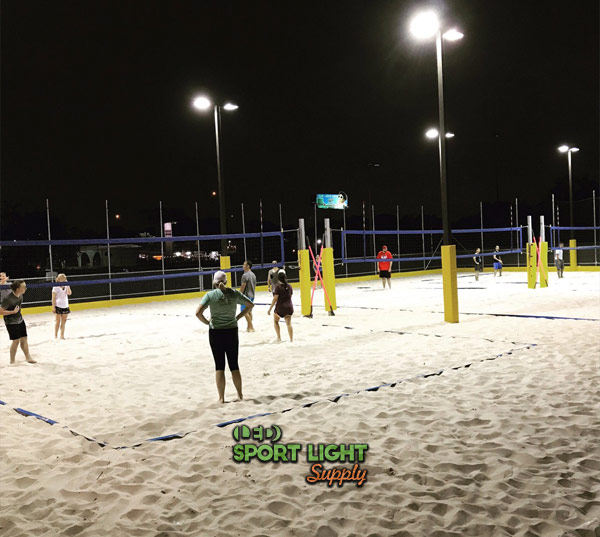
Poor Light Uniformity
Another critical issue is low light uniformity, which can lead to various problems including eye strain, uncomfortable vision, and difficulties in following the game’s dynamics. Poor uniformity affects players’ ability to see and react to the ball, which can result in mistakes, such as misjudging the ball’s trajectory or making incidental contact with the net. Ensuring even light distribution across the court is essential for maintaining player comfort and safety.
Addressing Lighting Mistakes
To avoid these common lighting issues, always refer to official volleyball court lighting standards for guidance. Obtaining a DIALux photometric lighting report can be a practical step. This simulation report provides detailed information on lux levels, light uniformity, and glare, helping to create an effective lighting plan. Consulting with lighting experts ensures that all requirements are met efficiently, providing the ideal lighting conditions for both recreational and professional play.
Conclusion
Choosing the right lighting for a volleyball court involves considering various options to meet specific needs. Flood lights offer broad, uniform illumination and are often equipped with modern LEDs or solar panels for efficiency and flexibility. Spot lights provide targeted lighting for specific areas and can be adjusted for different intensities. Solar lights are ideal for outdoor settings with minimal wiring, though their performance can be affected by battery wear and environmental factors. Portable light towers are versatile for temporary or emergency use, offering adjustable height and various configurations. Each lighting solution has its strengths, and selecting the best one depends on the court’s requirements and conditions.
